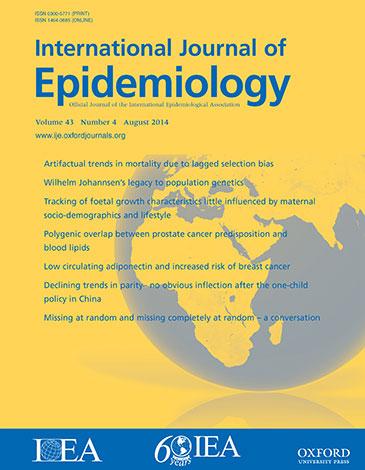Inconsistent consistency: evaluating the well-defined intervention assumption in applied epidemiological research
IF 6.4
2区 医学
Q1 PUBLIC, ENVIRONMENTAL & OCCUPATIONAL HEALTH
引用次数: 0
Abstract
Background According to textbook guidance, satisfying the well-defined intervention assumption is key for estimating causal effects. However, no studies have systematically evaluated how the assumption is addressed in research. Thus, we reviewed how researchers using g-methods or targeted maximum likelihood estimation (TMLE) interpreted and addressed the well-defined intervention assumption in epidemiological studies. Methods We reviewed observational epidemiological studies that used g-methods or TMLE, were published from 2000–21 in epidemiology journals with the six highest 2020 impact factors and met additional criteria. Among other factors, reviewers assessed if authors of included studies aimed to estimate the effects of hypothetical interventions. Then, among such studies, reviewers assessed whether authors discussed key causal-inference assumptions (e.g. consistency or treatment variation irrelevance), how they interpreted their findings and if they specified well-defined interventions. Results Just 20% (29/146) of studies aimed to estimate the effects of hypothetical interventions. Of such intervention-effect studies, almost none (1/29) stated ‘how’ the exposure would be intervened upon; among those that did not state a ‘how’, the ‘how’ mattered for consistency (i.e., for treatment variation irrelevance) in 64% of studies (18/28). Moreover, whereas 79% (23/29) of intervention-effect studies mentioned consistency, just 45% (13/29) interpreted findings as corresponding to the effects of hypothetical interventions. Finally, reviewers determined that just 38% (11/29) of intervention-effect studies had well-defined interventions. Conclusions We found substantial deviations between guidelines regarding meeting the well-defined intervention assumption and researchers’ application of the guidelines, with authors of intervention-effect studies rarely critically examining the assumption’s validity, let alone specifying well-defined interventions.不一致的一致性:评价应用流行病学研究中明确的干预假设
根据教科书的指导,满足明确的干预假设是估计因果效应的关键。然而,没有研究系统地评估如何在研究中解决这一假设。因此,我们回顾了研究人员如何使用g方法或目标最大似然估计(TMLE)来解释和解决流行病学研究中定义明确的干预假设。方法我们回顾了2000-21年间发表在流行病学期刊上的使用g-method或TMLE的观察性流行病学研究,这些研究具有6个最高的2020年影响因子,并符合其他标准。在其他因素中,审稿人评估纳入研究的作者是否旨在估计假设干预措施的效果。然后,在这些研究中,审稿人评估作者是否讨论了关键的因果推理假设(例如一致性或治疗差异无关),他们如何解释他们的发现,以及他们是否指定了定义良好的干预措施。结果只有20%(29/146)的研究旨在评估假设干预措施的效果。在这些干预效果研究中,几乎没有(1/29)研究表明“如何”干预暴露;在那些没有说明“如何”的研究中,64%的研究(18/28)中“如何”对一致性(即治疗差异无关性)很重要。此外,尽管79%(23/29)的干预效果研究提到了一致性,但只有45%(13/29)的研究将结果解释为与假设干预的效果相对应。最后,审稿人确定只有38%(11/29)的干预效果研究具有明确的干预措施。结论:我们发现,在满足明确的干预假设方面,指南与研究人员对指南的应用存在重大偏差,干预效果研究的作者很少严格检查假设的有效性,更不用说指定明确的干预措施了。
本文章由计算机程序翻译,如有差异,请以英文原文为准。
求助全文
约1分钟内获得全文
求助全文
来源期刊

International journal of epidemiology
医学-公共卫生、环境卫生与职业卫生
CiteScore
13.60
自引率
2.60%
发文量
226
审稿时长
3 months
期刊介绍:
The International Journal of Epidemiology is a vital resource for individuals seeking to stay updated on the latest advancements and emerging trends in the field of epidemiology worldwide.
The journal fosters communication among researchers, educators, and practitioners involved in the study, teaching, and application of epidemiology pertaining to both communicable and non-communicable diseases. It also includes research on health services and medical care.
Furthermore, the journal presents new methodologies in epidemiology and statistics, catering to professionals working in social and preventive medicine. Published six times a year, the International Journal of Epidemiology provides a comprehensive platform for the analysis of data.
Overall, this journal is an indispensable tool for staying informed and connected within the dynamic realm of epidemiology.
 求助内容:
求助内容: 应助结果提醒方式:
应助结果提醒方式:


